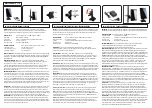
4 Secure the antenna to the pedestal using the hex screws , spring washers , and flat washers you
removed from the antenna in step 2.
5 Using a torque wrench, tighten the hex screws to 0.81 kgf-m (70 lfb-in. [6 lbf-ft.]) to fasten the antenna to the
pedestal without damaging the antenna or the mounting hardware.
Wiring and Connection Considerations
It may be necessary to drill a hole up to 32 mm (1
1
/
4
in.) in diameter for routing the power, network, or
grounding cables.
You must apply marine sealant to the hole after the cables are in place to ensure a waterproof seal.
If you must make the routing hole in a visible location, 32 mm (1
1
/
4
in.) decorative cable grommets can be
purchased from your local Garmin dealer, or you can go to
(optional).
• If needed, you can trim the grommet to enable you to route multiple cables through the same hole.
• The optional grommet does NOT provide a waterproof seal. You must apply marine sealant to the grommet
after the cables are in place to ensure a waterproof seal.
When installing the cables, you should observe these considerations.
• The ground cable is not included, and must connect to a water ground location, not the negative terminal of
the battery (
).
• To ensure safety, appropriate tie-wraps, fasteners, and sealant should be used to secure the cable along the
route and through any bulkheads or the deck.
• You should not run cables near moving objects and high-heat sources, or through doorways and bilges.
• To avoid interference with other equipment, you should not run network and power cables parallel to other
cables, such as radio antenna lines or power cables. If this is not possible, the cables should be shielded with
metal conduit or a form of EMI shielding.
• You should install the power cable as close to the battery source as possible.
◦
If it is necessary to extend the power cable, you must use the appropriate wire gauge (
).
◦
Incorrectly extended runs of cable may cause the radar to malfunction due to insufficient power
transmission.
8






































